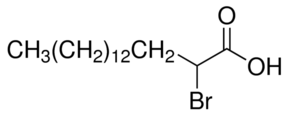All AbMole products are for research use only, cannot be used for human consumption.

2-Bromohexadecanoic acid (2-Bromopalmitic acid, 2-BP) is a palmitoylation inhibitor targeting DHHC (Asp-His-His-Cys) protein palmitoyltransferase. 2-BP inhibits palmitoylation of GSDME-C during pyroptosis and inhibits BAK/BAX-Caspase 3-GSDME pathway-mediated pyroptosis. It has also been shown to inhibit fatty acid oxidation, inhibit DHHC-mediated palmitoylation, and promote glucose uptake in rat cardiac cells and the insulin-sensitive murine fibroblast line A31-IS.

Cells. 2025 Mar 06;14(5):385.
Selective Azapeptide CD36 Ligand MPE-298 Regulates oxLDL-LOX-1-Mediated Inflammation and Mitochondrial Oxidative Stress in Macrophages
2-Bromohexadecanoic acid purchased from AbMole
| Molecular Weight | 335.32 |
| Formula | CH3(CH2)13CH(Br)CO2H |
| CAS Number | 18263-25-7 |
| Solubility (25°C) | DMSO > 60 mg/mL Methanol 60 mg/mL |
| Storage |
Powder -20°C 3 years ; 4°C 2 years In solvent -80°C 6 months ; -20°C 1 month |
[2] Han Yao, et al. Inhibiting PD-L1 palmitoylation enhances T-cell immune responses against tumours
[3] Yi Yang, et al. Palmitoylation stabilizes PD-L1 to promote breast tumor growth
[5] Kojiro Mukai, et al. Activation of STING requires palmitoylation at the Golgi
| Related Pyroptosis Products |
|---|
| INF 195
INF 195 is an NLRP3 inhibitor. |
| Azalamellarin N
Azalamellarin N is an inhibitor of pyroptosis and has different inhibitory effects on different pyroptosis inducers. Azalamellarin N inhibits pyroptosis by targeting molecules that act upstream of NLRP3 inflammasome activation, rather than directly targeting components of the NLRP3 inflammasome. |
| Sodium metatungstate
Sodium metatungstate (Sodium polyoxotungstate) is a potent ecto-nucleoside triphosphate diphosphohydrolase (ENTPDase) inhibitor, with Ki values of 2.58 μM, 3.26 μM, and 28.8 μM for NTPDase 1 (CD39), NTPDase 3 and NTPDase 2 respectively. |
| LDC7559
LDC7559 is a gasdermin D (GSDMD) inhibitor via blocking neutrophil extracellular trap (NET) in the late stages . |
| CY-09
CY-09 is a selective direct inhibitor of NLRP3 with anti-inflammatory and antidepressant activity, which inhibits inflammatory cytokine production and TRPA1 activation by inhibiting the activation of the NLRP3 inflammatory vesicle, thereby decreasing the intracellular Ca2+ level and reducing the pro-inflammatory polarization of macrophages, alleviating pain and injury in animals. In addition, CY-09 can inhibit pyroptosis. |
All AbMole products are for research use only, cannot be used for human consumption or veterinary use. We do not provide products or services to individuals. Please comply with the intended use and do not use AbMole products for any other purpose.


Products are for research use only. Not for human use. We do not sell to patients.
© Copyright 2010-2024 AbMole BioScience. All Rights Reserved.
